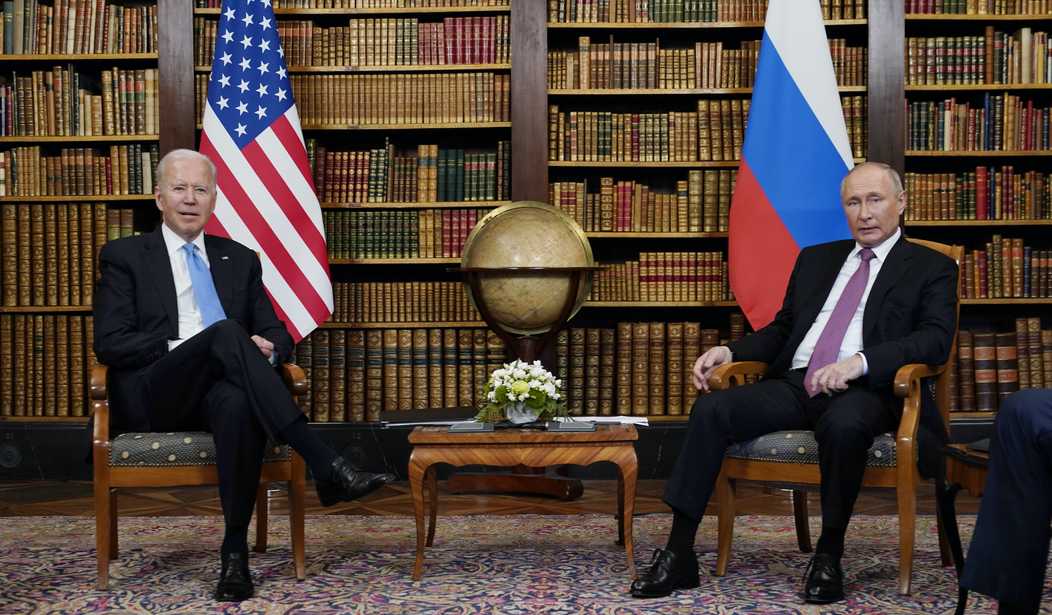Credit for this observation goes to Stephen Miller who posted it on Twitter this morning. Russian President Vladimir Putin has been threatening to invade Ukraine (again) and yesterday Washington Post columnist David Ignatius devoted an entire piece to blaming that potential outcome on the president. No, not the current president who has been in office for nearly 11 months, the previous president. His piece is headlined, “Putin barrels toward invading Ukraine, encouraged by Trump.” It’s an embarrassing jumble of nonsense. Here’s how it opens:
Russian President Vladimir Putin’s path toward threatening an invasion of Ukraine is marked by reckless actions. In this move toward defiance of international norms, Putin has been subtly encouraged by former president Donald Trump, a fellow traveler in recklessness…
If Putin does march into Ukraine, one consequence ought to be severe damage for Trump’s political future…before it’s too late, we should examine how Putin has broken through the guardrails with Trump’s silent acquiescence or outright approval.
Gradually, after a rehash of Trump’s greatest hits, Ignatius makes his way back to present reality:
Putin took his recklessness into space last month, in the run-up to the Ukraine crisis. Russia fired a missile at one of its own satellites to test such shoot-down capability…Sen. Angus King (I-Maine) thinks Putin wanted to show the world he could be that ruthless…
Okay, but why did he do that now? Why didn’t he do it last year when Trump was in office? In paragraph 12 (out of 13) Ignatius finally suggests a possible reason: [emphasis added]
Trump supporters blame Biden for making Putin think America is in retreat. There’s no question that the world is worried about U.S. resolve after the chaotic Afghanistan withdrawal, but in the Ukraine crisis Biden has behaved with the right mix of firmness and diplomacy.
Notice how he puts criticism of Biden’s Afghanistan exit in the mouths of Trump supporters. Anyone who has looked at polls in the past several months knows Biden’s polling took a major hit during the withdrawal and hasn’t really recovered. So the idea that it’s just the right who didn’t approve of his handling of Afghanistan is intentionally misleading. He’s signaling to readers that this is a bad opinion even though it’s a pretty logical one.
Enemies responding to moments of perceived weakness is a tale as old as time. And it’s not just the exit from Afghanistan where Biden is struggling. How well have Biden’s talks with Iran gone so far? Not very well it turns out. How about his handling of the border crisis? Historically bad. How about his handling of the nuclear sub deal with Australia? Not ideal.
More to the point, Ignatius doesn’t even mention recent actions that seem pretty relevant. The buildup of Russian troops along the Ukraine border started back in April. In response to that buildup, the US began planning a large sale of arms to the Ukraine but that sale was put on hold after Russia announced it was pulling back from the border. But the NY Times pointed out in early May that most of the troops and equipment hadn’t been moved at all.
Russia has withdrawn only a few thousand troops from the border with Ukraine, senior Biden administration officials said, despite signals from Moscow last month that it was dialing down tensions in the volatile region.
Senior Defense Department officials said that close to 80,000 Russian troops remained near various strips of the country’s border with Ukraine, still the biggest force Russia has amassed there since Moscow annexed Crimea in 2014.
The Russian military did order some units back to their barracks by May 1 — and they did move from the border — the officials said. But many of the units left their trucks and armored vehicles behind, a signal that they could go back if President Vladimir V. Putin of Russia decided to deploy them again.
This crisis has been brewing since April not just along the border but with the massing of Russian naval vessels in the Black Sea as well. The Russian pullback was a headfake and a couple weeks later Russian hackers shut down a major pipeline in the US with ransomware, creating a gas shortage in several states and a federal emergency declaration. Biden responded not long after by removing sanctions on a Russian pipeline, sanctions which had been put in place by Trump. Again, David Ignatius never mentions any of this, which seems odd if you’re really interested in Russian belligerence and a tepid US response to it.
There are all sorts of possible antecedents for Putin’s recent behavior, some of which may indeed go back to Trump. But it doesn’t make much sense to point to things Trump said in 2016 and skip lightly over what has been happening for the past 11 months. The Afghanistan debacle in particular made the US look weak and ill-prepared for conflict. Devoting one clause of a sentence buried at the bottom of a story really doesn’t do that justice. If you’re looking for reasons why Putin is massing troops at the border, blowing up satellites and generally daring the US to react to his provocations, you can start by looking at the current White House and the current president.









Join the conversation as a VIP Member